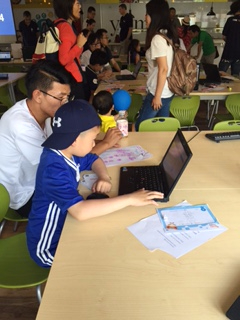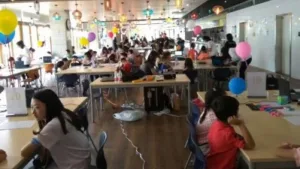Innovation in Education ???? can be found just about anywhere in the world, and in this case, the proud host city was Shanghai, China. I came to China to speak about virtual-reality at a TEDx event, but had the privilege to attend and take in a powerhouse educational event–a hackathon held at the Shanghai HD Bilingual School

 The Bund in Shanghai
The Bund in Shanghai
This was an event sponsored by LeapLearner, an educational technology company dedicated to bringing the power of coding to the youngest among us.
 Coding for the crayon crowd
Coding for the crayon crowd
“Coding” is the new and popular term for one of the oldest phenomena of the technology revolution in schools: programming. In some corners of the world, it has also earned the moniker “computational thinking”. Although coding is often thought to be the sole domain of the high school and higher-end student, the Shanghai-based LeapLearner company is dedicated to ushering in the power of coding (and its ability to support critical thinking, problem solving, math and computation) to children as young as five years old space (and their often-surprised parents).
 The author congratulates the LeapLearner Frog
The author congratulates the LeapLearner Frog
In the United States, a “hackathon” is a large event, often held in schools, that brings students together to create ‘code’ (that is, ‘program’ computers or other devices) in either collaborative or competitive formats. In this case, the Shanghai hackathon took shape as an event in which parents and their own children could come together and experience the educational joy of creating code, solving problems, and creating games at the same time. Most importantly, at this hackathon parents saw misconceptions melt away as adults witnessed very young children, their children, successfully conquer the world of variables, loops, and functions on their way to successfully designing and improving actual computer games or simulations.

The hackathon was a lively event
A solid part of the worldwide “maker movement “, the coding revolution has increasingly taken on the role of a timely and critical new literacy skill for the next generation of students. LeapLearner has capitalized on this trend with an outstanding technical platform, a comprehensive two-year curriculum for elementary children, school- or parent-sponsored hackathon events, and the ability to showcase student accomplishments in the cloud.
 Here’s how it’s done, Dad!
Here’s how it’s done, Dad!
So why is this important to the display-minded reader, you ask? It’s simple. You may produce, promote, or distribute amazing technologies, but all technology needs a reason for existing. Coding, is a 21st century literacy skill and is one of those reasons. And a very good one. In fact, “coding as literacy” is poised to be named as one of the key trends for the near future the upcoming 2017 K 12 Horizon Report. That’s good, too, for the display industry.
 Testing the final product…
Testing the final product…
In China, as in the U.S., coding is still not mainstream within the school curriculum. Still, at this hackathon, displays of every size and shape were ubiquitous. Displays were in the hands of both very young children and their often surprised parents. Displays were being used to create, to design, to evaluate, to debug, to present, and to share student work even beyond this event. What sells displays? Great applications like coding, conspicuous learning, and delighted parents– these are the building blocks that help sell displays. –Len Scrogan

